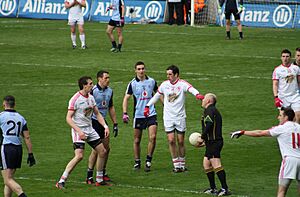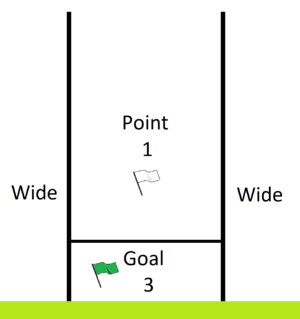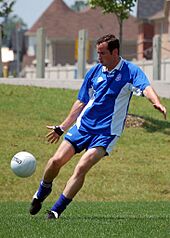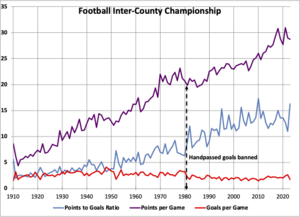Gaelic football facts for kids
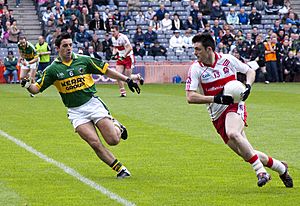
Gaelic footballers in action during the 2009 National Football League Final
|
|
| Highest governing body | Gaelic Athletic Association (GAA) |
|---|---|
| Nicknames | Caid Football Gaelic Gaa |
| First played | 1885 |
| Clubs | More than 2,500 |
| Characteristics | |
| Contact | Limited |
| Team members |
|
| Mixed-sex | No |
| Type | Outdoor |
| Equipment | Gaelic ball |
| Venue | Gaelic games field |
| Presence | |
| Olympic | 1904 (demonstration sport) |
| Paralympic | No |
Gaelic football (Irish: Peil Ghaelach), often called Gaelic or GAA, is a popular Irish team sport. It is a type of football played between two teams of 15 players. The game takes place on a large grass field.
The main goal is to score points by kicking or punching the ball. You get 3 points for a "goal" (kicking the ball into the net). You get 1 point for kicking or punching the ball over the crossbar and between two tall posts. Players move the ball by carrying, bouncing, kicking, or hand-passing it. A "solo" means dropping the ball and kicking it back up to yourself.
Gaelic football is one of four "Gaelic games" managed by the Gaelic Athletic Association (GAA). The GAA is the biggest sports group in Ireland. Along with hurling and camogie, Gaelic football is a strictly amateur sport. This means players, coaches, and managers do not get paid. The sport is mostly played in Ireland. However, it is also played by Irish people living in other parts of the world.
The final of the All-Ireland Senior Football Championship is a huge event. It happens every year at Croke Park in Dublin. Over 80,000 people come to watch. Outside Ireland, the game is popular among the Irish diaspora. A special place called Gaelic Park in New York City is the biggest Gaelic sports venue outside Ireland. There are three main competitions: the National Football League and the All-Ireland Senior Football Championship for county teams. The All-Ireland Senior Club Football Championship is for individual clubs. The All-Ireland Senior Championship is the most important event.
Gaelic football is for male players. However, there is a similar sport called ladies' Gaelic football for women. It is run by the Ladies' Gaelic Football Association. Gaelic football has some similarities to Australian rules football. This led to a new sport called international rules football. Teams from Ireland and Australia play against each other in this hybrid game.
Contents
History of Gaelic Football
Gaelic football as we know it today started in the late 1800s. But different kinds of football were played in Ireland long before that.
Early Irish Football (Caid)
The first mention of football in Irish law was in 1308. A law in 1527 allowed "foot balle" but banned other sports. By the 1600s, these games became very popular. Rich landowners even helped organize matches. Teams could have 20 or more players. People often bet money on the games.
In 1670, a game in County Meath allowed both catching and kicking the ball. This was an early form of the modern game. A law in 1695 tried to ban sports on Sundays. But it was hard to stop people from playing. The first recorded match between counties was in 1712. It was played between Louth and Meath.
In the early 1800s, different football games were popular in County Kerry. They were all called caid. One type was a "field game" where players kicked the ball through tree branches. Another was a "cross-country game" that lasted all Sunday. Players could wrestle, hold opponents, and carry the ball.
Irish Football Abroad
We also learn about early Irish football from Irish people who moved to other countries. Many Irish immigrants played these games in Britain, the United States, Australia, and New Zealand. In Australia, Irish football was played as early as the 1840s. One big difference was that traditional Irish football allowed "shin-kicking." This was one reason it did not become widely popular in Australia.
Modern Gaelic Football Appears
In the 1860s and 1870s, rugby football became popular in Ireland. The rules of English football (soccer) were also becoming well-known. At this time, the old caid games were changing. They became rougher, even allowing tripping.
The first signs of what would become modern Gaelic football appeared around 1873. In County Kerry, a new type of football started to spread. It was very similar to Australian rules football. This game used an oval ball and only allowed goals to be scored by kicking.
Irish football is a great game and worth going a long way to see when played on a fairly laid out ground and under proper rules. Many old people say just hurling exceeded it as a trial of men. I would not care to see either game now as the rules stand at present. I may say there are no rules and therefore those games are often dangerous.
Some historians believe that elements like the "mark" (a free kick for a clean catch) and no offside rule might have come from English football clubs. County Limerick was a strong area for the game in the 1880s. The Commercials Club in Limerick made its own rules. These rules are thought to be the basis for the rules the GAA later adopted.
By the mid-1880s, English football (soccer) was becoming very popular. Many people worried it would completely replace Irish football.
Ball-playing, hurling, football kicking, according to Irish rules, 'casting', leaping in various ways, wrestling, handy-grips, top-pegging, leap-frog, rounders, tip-in-the-hat, and all such favourite exercises and amusements amongst men and boys, may now be said to be not only dead and buried, but in several localities to be entirely forgotten and unknown.
But Irish football stayed strong in the southern counties. By 1889, the popular Irish football game was different from the old mob football. It seemed to be a mix of English and Scottish football.
Rules and Organization
The Gaelic Athletic Association (GAA) was formed in 1884. It wanted to promote traditional Irish sports like hurling. It also wanted to move away from "foreign" sports, especially English ones. The first rules for Gaelic football were created by Maurice Davin in 1884. They were published in 1887. These rules were influenced by hurling and some Australian rules. They were designed to be different from soccer and rugby. For example, there was no offside rule.
The first game under GAA rules was played in County Kilkenny in 1885. From 1886, the GAA banned tackling. The original rules allowed kicking and hand-passing. They also had a basic scoring system. However, carrying the ball was not allowed at first. Players could only carry the ball if they bounced or soloed it later on. The game was meant to be peaceful. Davin even suggested players hold hands with opponents, but this did not last.
GAA Rules of 1887 (Simplified)
Here are some of the key rules from 1887:
- The field was about 140 yards long and 84 yards wide.
- Teams had 14 to 21 players.
- There were two umpires and a referee.
- Goalposts were 21 feet apart with a crossbar 8 feet high.
- A goal was scored by kicking the ball under the crossbar.
- A point was scored by kicking the ball over the crossbar.
- Fouls included pushing, tripping, holding from behind, and wrestling.
- Games lasted one hour, with sides changing at half-time.
- Players had to strike the ball with their hand.
- You could catch the ball in the air and kick it.
- You could not carry or throw the ball forward.
- No nails or iron tips were allowed on boots.
Game Spreads and Nationalism

Gaelic football spread around the world in the late 1800s. It was played in North America (Canada and the United States) by 1892. Clubs also started in England in 1896. Around 1900, the game became more like it is today. Players could lift the ball and run with it if they bounced it every four yards. The first match in Australia was in 1902.
Some GAA groups started to have strong nationalistic rules. For example, in Connacht, some leagues gave free kicks if players spoke any language other than Irish. The referee was only allowed to speak Irish.
On Bloody Sunday in 1920, during the Irish War of Independence, a football match at Croke Park was attacked. 14 people were killed. One of them was Tipperary footballer Michael Hogan. The Hogan Stand at Croke Park is named after him. In 1930, the GAA banned children who played rugby instead of Gaelic football.
20th Century Gaelic Football
In 1939, a game between Kerry and Galway was played at Yankee Stadium in New York City. About 70,000 people watched. By 1958, Wembley Stadium in England hosted yearly Gaelic football games. Tens of thousands of fans attended. Ladies' Gaelic football has become much more popular since the 1970s.
Playing with Australia (Since 1967)
In 1967, an Australian journalist named Harry Beitzel watched the All-Ireland senior football final. He was inspired and sent an Australian team to play against Irish teams. This was the first big interaction between the two sports.
Now, there is an International Rules Series where players from both sports play each other. The GAA picks the team for Ireland, and the AFL picks the team for Australia. Famous stadiums like Croke Park and the MCG host these games. Some Irish players have also become very successful in Australian rules football. One example is Jim Stynes from Dublin. He won an All-Ireland football championship and later became a top player in Australia.
Rules of the Game
How to Play
Players move the football up the field in different ways. They can carry it, bounce it, kick it, or hand-pass it. A "solo" means kicking the ball up to yourself and catching it. There are two ways to score: points and goals. A point is 1 point, scored by kicking or hand-passing the ball over the crossbar. An umpire raises a white flag for a point. A goal is worth 3 points, scored by kicking the ball into the net. An umpire raises a green flag for a goal. You cannot hand-pass the ball into the goal.
Positions in Gaelic football are like other football games. Each team has a goalkeeper, six backs, two midfielders, and six forwards. Teams can also have many substitute players.
The Playing Field
A Gaelic pitch is like a rugby field but bigger. It is a rectangle of grass, about 130 to 145 meters long. It is also about 80 to 90 meters wide. At each end, there are H-shaped goalposts. These posts are usually 6 to 7 meters high and 6.5 meters apart. A crossbar connects them 2.5 meters above the ground. A net hangs behind the goal. The same field is used for hurling. Lines are marked at 13, 20, and 45 meters from each end-line. Younger teams use smaller fields and goals.
Game Length
Most adult football games last for 60 minutes. This is split into two halves of 30 minutes. However, senior inter-county games are 70 minutes long (two 35-minute halves). If a game is a draw, they might play extra time (two 10-minute halves). Junior games can have shorter halves. There is a break at half-time, usually 5 to 15 minutes. Championship matches have a 30-minute break.
Teams and Players
Each team has 15 players on the field. These include a goalkeeper, six defenders, two midfielders, and six forwards. Teams can also have up to 15 substitutes. Six substitutes can be used during the game. Sometimes, younger teams or teams with fewer players play with 13 players. Each player wears a number from 1 to 15. The goalkeeper wears a different colored jersey.
The Ball
The game uses a round leather football. It is made of 18 stitched leather panels. The ball is about 68 to 70 cm around and weighs 480 to 500 grams when dry. You can kick it or hand-pass it. A hand-pass is not a throw. It is a strike of the ball with the side of a closed fist.
The Mark
In 2017, the GAA added a rule called the 'mark'. It is similar to the mark in Australian rules football. If a player catches the ball cleanly from a kick-out, they get a free kick. This happens if the ball does not touch the ground and is caught on or past the 45-meter line. The player can either take the free kick or keep playing right away.
In 2020, new types of marks were added. The Advanced Mark is when an attacking player catches the ball cleanly inside the opponent's 45-meter line. The kick must be forward, travel over 20 meters, and not touch the ground or another player. The referee blows the whistle, and the player can take a free kick or play on. There is also a Defensive Mark for defenders who catch a long ball.
Types of Fouls
There are three main types of fouls in Gaelic football. Fouls can lead to the other team getting the ball, a player getting a warning, or even being sent off the field.
Technical Fouls
These fouls are about how you handle the ball:
- Taking five steps without bouncing, soloing, or releasing the ball.
- Bouncing the ball twice in a row (you can solo it many times).
- Throwing the ball between your hands (this is allowed in ladies' Gaelic football).
- Throwing the ball (you must "hand-pass" it by striking with your fist).
- Hand-passing a goal (you must kick it into the net). You can punch the ball over the bar for a point. You can also punch it into the net if another player passed it to you or it hit the post/crossbar/ground first.
- Picking the ball directly off the ground (you must scoop it up with your foot). In ladies' Gaelic football, you can pick it up directly.
- The "square ball" rule: If an attacking player is inside the small square when the ball enters it, the other team gets a free kick. This rule mostly applies to free kicks or set pieces.
Aggressive Fouls
These are physical or verbal fouls against an opponent or the referee.
A player can get a yellow card (caution). They can be sent off the field without a substitute (red card). Or, they can be sent to the "Sin Bin" for ten minutes (black card). If a player gets two black cards, they get a red card.
Dissent Fouls
These fouls happen when a player does not follow the officials' decisions or instructions. A player can get a yellow card or a red card. The free kick might be moved 13 meters further down the field. In some cases, the game can even be stopped. Examples of dissent fouls include:
- Challenging an official's authority.
- Not using a mouthguard when told to.
- Refusing to leave the field after an injury with bleeding.
- Showing disagreement with a referee's free kick decision.
- Refusing to leave the field when sent off.
- A team or player leaving the field without permission or refusing to play.
Scoring in Gaelic Football
If the ball goes over the crossbar, it is a point (1 point). An umpire raises a white flag. You can kick or fist the ball over the crossbar. If the ball goes under the crossbar into the net, it is a goal (3 points). An umpire raises a green flag. You must kick the ball for a goal. You cannot fist-pass it into the net. However, you can punch the ball into the net if it was passed to you or hit a post/crossbar/ground first. The goalkeeper guards the goal.
Scores are written like this: Goal Total-Point Total. For example, if Team A scores 0–21 and Team B scores 4–8:
- Team A has 21 points.
- Team B has 4 goals (4 x 3 = 12 points) plus 8 points, for a total of 20 points.
- So, Team A wins with 21 points to Team B's 20 points.
Tackling Rules
Tackling in Gaelic football is less rough than in rugby or Australian rules. You can make shoulder-to-shoulder contact. You can also slap the ball out of an opponent's hand.
The following actions are fouls:
- Blocking a shot with your foot.
- Pulling an opponent's jersey.
- Pushing an opponent.
- Sliding tackles.
- Striking an opponent.
- Touching the goalkeeper when they are in the small rectangle.
- Tripping.
- Using both hands to tackle.
- Wrestling the ball from an opponent's hands.
Restarting Play
- A game starts with the referee throwing the ball up between the four midfielders.
- After a point or goal, or if an attacker kicks the ball wide, the goalkeeper takes a kick out. This is a free kick from the 13-meter line. All players must be beyond the 20-meter line.
- If a defender kicks the ball wide, an attacker takes a "45". This is a free kick from the 45-meter line, where the ball went wide.
- If a player kicks the ball over the sideline, the other team takes a sideline kick. This is taken from where the ball left the field.
- After a foul, the other team gets a free kick (or "free"). This is taken from where the foul happened.
- If a player is fouled while passing the ball, the free kick can be taken from where the ball landed.
- If a defender fouls inside the large rectangle, the other team gets a penalty kick. This is a free kick from the center of the 11-meter line. Only the goalkeeper can guard the goal.
- If many players are fighting for the ball and it is unclear who fouled, the referee can throw the ball up between two opposing players.
Game Officials
Up to eight officials oversee a football match:
- The referee
- Two linesmen
- A sideline official (for inter-county games)
- Four umpires (two at each goal)
The referee starts and stops the game, records the score, gives free kicks, and cautions or sends off players. Linesmen show the referee where the ball went out of bounds. The sideline official manages substitutions and shows extra time. Umpires judge scoring. They use flags to show if a shot was wide, a point, or a goal.
Team of the Century
The Team of the Century was chosen in 1984. Readers of the Sunday Independent nominated players. Then, a group of experts, including journalists and former players, made the final choices. The goal was to pick the best 15 players in each position. Many fans debated the choices!
| Goalkeeper | |||
| Dan O'Keeffe (Kerry) |
|||
| Right corner back | Full back | Left corner back | |
| Enda Colleran (Galway) |
Paddy O'Brien (Meath) |
Seán Flanagan (Mayo) |
|
| Right half back | Centre back | Left half back | |
| Sean Murphy (Kerry) |
John Joe O'Reilly (Cavan) |
Stephen White (Louth) |
|
| Midfield | |||
| Mick O'Connell (Kerry) |
Jack O'Shea (Kerry) |
||
| Right half forward | Centre forward | Left half forward | |
| Seán O'Neill (Down) |
Seán Purcell (Galway) |
Pat Spillane (Kerry) |
|
| Right corner forward | Full forward | Left corner forward | |
| Mikey Sheehy (Kerry) |
Tommy Langan (Mayo) |
Kevin Heffernan (Dublin) |
Team of the Millennium
The Team of the Millennium was chosen in 1999. A group of GAA leaders and journalists picked this team. The goal was to find the best 15 players in each position since the GAA started in 1884. This team was chosen to celebrate the year 2000. Just like the Team of the Century, these choices were often debated by fans!
| Goalkeeper | |||
| Dan O'Keeffe (Kerry) |
|||
| Right corner back | Full back | Left corner back | |
| Enda Colleran (Galway) |
Joe Keohane (Kerry) |
Seán Flanagan (Mayo) |
|
| Right half back | Centre back | Left half back | |
| Seán Murphy (Kerry) |
John Joe O'Reilly (Cavan) |
Martin O'Connell (Meath) |
|
| Midfield | |||
| Mick O'Connell (Kerry) |
Tommy Murphy (Laois) |
||
| Right half forward | Centre forward | Left half forward | |
| Seán O'Neill (Down) |
Seán Purcell (Galway) |
Pat Spillane (Kerry) |
|
| Right corner forward | Full forward | Left corner forward | |
| Mikey Sheehy (Kerry) |
Tommy Langan (Mayo) |
Kevin Heffernan (Dublin) |
How Competitions Work
Gaelic sports are amateur at all levels. This means players, even top ones, do not get paid to play.
The main competitions are the League and the Championship. The Championship is a knock-out tournament and is usually seen as more important.
Games start at the club level. Clubs are usually based in local areas. Local clubs play against other clubs in their county. They try to win the County Club Championship. There are different levels for adults (senior, junior, intermediate) and for children (under-21, minor, under-age). A club can have more than one team.
| Name | Description |
|---|---|
| Senior | For the best adult teams. |
| Junior | For less strong adult teams, often from smaller places. |
| Intermediate | For teams in between Senior and Junior levels. |
| Name | Description |
|---|---|
| Under-21 | For players under 21 years old. |
| Minor | For players under 18 (or under 17 for county teams). |
| Under-age | For players of all ages from under-17 down to under-6. |
Even though Ireland is split into two countries, Gaelic games are organized for the whole island. There are 32 GAA counties. Most of these are the same as the actual counties in Ireland. There are also GAA "counties" overseas, like London and New York. Clubs are found all over the world.
County teams play against each other in "inter-county" games. The most famous inter-county competition is the All-Ireland Championship. Almost all counties play in this tournament every year. Many people go to stadiums across Ireland, especially Croke Park, to support their county team.
The All-Ireland Championship starts with provincial championships. Counties play against others in their province (Ulster, Munster, Leinster, and Connacht). The four winners go straight to the All-Ireland series. In the past, provincial winners played in semi-finals. Now, a "back door" system gives teams a second chance. Teams knocked out early can still qualify for the All-Ireland quarter-finals. This means a team can lose early but still become All-Ireland champions, like Tyrone did in 2005 and 2008.
The second most important inter-county competition is the National League. The National Football League happens every spring. Counties are put into four divisions based on how strong they are. The League is not as famous as the Championship. But in recent years, more people have been watching it. Live matches are shown on TV channels like Setanta Sports and TG4.
There are also All-Ireland championships for county teams at Junior, Under-21, and Minor levels. Club teams also have provincial and national championships.
See also
 In Spanish: Fútbol gaélico para niños
In Spanish: Fútbol gaélico para niños
- All-Ireland Senior Football Championship
- All-Ireland Sevens Football
- Ladies' Gaelic football
- List of footballers (Gaelic football)
- List of Gaelic football clubs
- Sport in Ireland
- Comparison of Gaelic football and Australian rules football
- Comparison of Gaelic football and rugby union
- Association football in Northern Ireland
- Association football in the Republic of Ireland


